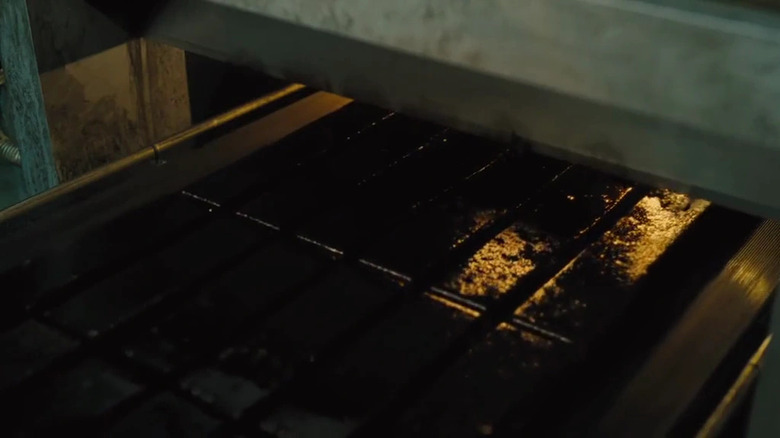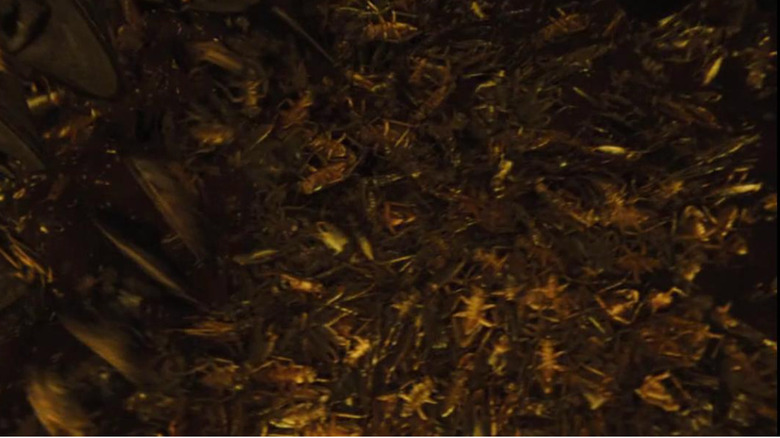Snowpiercer's Disgusting Protein Bars Were Based On A Real-Life Food
Bong Joon-ho's "Snowpiercer" is one of the best dystopian post-apocalyptic thrillers ever made. In the movie, the human survivors of Earth's second ice age have been living for the last 17 years on a self-sustaining circumnavigational train segregated by class. The wealthy flourish in extravagant, spacious cars in the front, while the poor — aka "Tailies" — are smashed into the slums of the tail cars and kept in line by armed guards. Based on the graphic novel "Le Transperceneige" by Jacques Lob, Benjamin Legrand, Olivier Bouquet, and Alexis Nolent, Bong Joon-ho's adaptation was a big enough success to inspire a TV series spin-off, and helped audiences see a new side of star Chris Evans, who had just two years before made his debut as Captain America in the Marvel Cinematic Universe.
"Snowpiercer" tackles themes of wealth and class disparity from multiple angles, one of which concerns the sustenance provided. The elite consumed high-class cuisine like filet mignon, while the poor consumed protein blocks of an unknown substance. At one point, Evans' character Curtis Everett sees how the blocks are made during the Tail Riders' Uprising, and it's revealed they've been eating ground-up cockroaches for years.
As disgusting as it may sound, insects are often treated as a delicacy in many parts of the world — and they're also extremely high in protein. Some companies even utilize crickets to make cricket flour, as the flour can be used in place of traditional flour for a high-protein, gluten-free substitute. But could the Tailies actually survive for 17 years off of protein bars? We at /Film interviewed two experts – Annette Snyder, MS, RD, CSOWM, LD, and Danielle Smith, RD, CWLS, Certified Registered Dietitian working with other G.I. disorders, eating disorders, diabetes, and weight management, both from Top Nutrition Coaching – to learn the science behind the protein bars and figure out if we could all survive off of bug bars when climate change forces us into our own cannibalistic caste system train cars.
The protein bars are based on real food, but can we survive off protein?
As Bong Joon-ho told Screen Anarchy back in 2013, the protein bars' look and texture were based on real-life food. "In Korea and Japan there is some sweet bar like that, that looks very similar, but it's very popular, very traditional, made of sweet beans," he explained. "That's not in the original graphic novel but the cheapest way of feeding the tail section people is cockroaches." The bar in question is a jellied Adzuki red bean paste block. The look is nearly identical to the "Snowpiercer" protein bars, but the taste is understandably much different. Adzuki has a sweet, nutty taste and is often used in desserts and ice cream. Due to the high protein content, the jellied bars are often advertised as an energy-charging snack.
"Snowpiercer" took the look of the bars and twisted it into something completely dystopian. "We can keep them alive, with just some cockroaches," director Bong said. "I think this is actually a very good idea, to feed a lot of people." In theory, it is a good idea, but our experts tell us that trying to sustain life off of just protein may have some complications. "Your body can technically get by on protein for energy (calories), for a time," Snyder tells us. "It's important to remember that fats and carbohydrates play a key role in keeping you healthy, too — and eventually the lack of diversity in your nutrition will catch up." One downside is that animal-based proteins are lacking in fiber and protective fats like omega-3s, as well as some vitamins, minerals, and protective plant compounds like antioxidants. "Carbohydrates are the body's primary energy source, especially necessary for brain function," says Smith. Fortunately, as Snyder explains, "Opting for protein from plant-based sources such as beans, lentils, soy, and yes, insects, can be more beneficial as these sources provide carbohydrates (like fiber), those 'good' fats, and antioxidants that are not usually found in strictly animal-based sources."
So while we could get by, our quality of life likely wouldn't be great and our brains wouldn't be in fighting shape to take down the wealthy elite at the front of the train. However, these protein facts are based on animal-based protein.
Protein-only diets can cause 'rabbit starvation'
Smith notes that protein-only diets can cause something known as "rabbit starvation," a colloquial term for protein poisoning. "Symptoms include diarrhea, headache, fatigue, low blood pressure, and a slow heart rate," she says. "This condition underscores the body's inability to thrive on protein alone, especially without adequate fat." If we're not getting enough calories, the protein we consume will be used in place of fuel instead of fulfilling its other important functions like "making immune cells, hormones, enzymes, and repairing damage to the body's tissues," Snyder says. And if our bodies are super struggling, they'll start eating away any available protein storage units — like our muscles — to try and generate energy.
"While a high-protein diet might sustain life for a short period under extreme conditions, it is not a viable long-term solution," says Smith. "Survival on such a diet would likely lead to numerous health complications, and it certainly would not support optimal health or quality of life." Most folks know that a lack of vitamin C causes scurvy, which most certainly would have ravaged much of the Tailies. Vitamin C isn't found in protein foods and many of the necessary B vitamins would be hard to come by. "Vitamin and mineral deficiencies can cause a myriad of problems, some life-threatening," says Snyder.
Another issue is that proteins and fats are considered backup systems for energy compared to the way our bodies transform carbohydrates into glucose and fuel. "Low amounts of the preferred fuel can lead to difficulty concentrating and low energy, among other things," says Snyder. Meaning that we'll be physically exhausted, weaker, and struggling to fight against our oppressors ... which is precisely the goal of those in power on the Snowpiercer.
But these protein bars are made of insects, not animals. Does that make a difference?
Cricket flour could give the Tailies a fighting chance
Cricket flour has been gaining popularity in some circles for those looking to add more protein to their diets and less gluten, but are there health benefits of insect-based proteins? Fortunately, both Snyder and Smith have identified plenty of benefits — in moderation, of course. "Not only are [cricket bars] packed with benefits for your health, but they're also kind to the planet," Smith says. They are a great source of high-quality protein as they contain all nine essential amino acids, and they're also a good source of vitamins and minerals like B12, iron, magnesium, selenium, zinc, and potassium.
They're also significantly lower in fat compared to livestock meat, and their exoskeletons contain chitin — a dietary fiber that helps with digestion and maintaining a healthy gut microbiome. Not to mention, farming insects for protein is more sustainable than conventional livestock. "Insects require significantly less land, water, and food and produce fewer greenhouse gasses," says Smith.
"In general, many insect proteins are just as nutritionally adequate as meat, and a few species (such as crickets and mealworms) have a higher nutritional value than beef or chicken," says Snyder. "Essentially, there are nutrients in insect proteins that you don't often find in traditional animal-based proteins." The naturally gluten-free alternative also benefits those with celiac disease and is highly digestible. "77-98% of the protein is absorbed and usable," says Snyder. She also pointed out that some species of edible insects even contain vitamins A, B, D, E, K, and C. Meaning, the "Snowpiercer" bars are at least a little bit more nutritionally beneficial than bars made of animal proteins.
There's just one problem: Many bug bars aren't safe for folks with shellfish allergies. No, seriously.
There's truth to the 'shrimps is bugs' meme after all
A few years back, I attended a convention where the "Snowpiercer" TV show was giving away protein bars made of cricket flour. Curiosity got the better of me and I had to try it out. The bar itself tasted no different than any other protein bar I had tried in the past, but I suddenly felt a warming sensation in my throat. Sparing some details ... did you know that crickets (and cockroaches) are related to shellfish, and that if you're allergic to shellfish, you're at risk of having an allergic reaction from consuming the insects? If you didn't know this, allow me to be a cautionary example of why it's very important to look at the health warnings on food wrappers.
"Both shellfish and insects contain a protein called tropomyosin, which can cause what's known as cross-reactivity," says Smith. "This means your immune system, which reacts to shellfish, might mistake the similar protein in insects for the same thing and trigger an allergic reaction." The amount of tropomyosin needed to trigger the reaction differs from person to person, so the best advice is to avoid it altogether. "There's no current consensus on how many cockroaches, if consumed, would lead to anaphylaxis," says Snyder. "However, if one has a severe allergy to shellfish, it may only take a bite to cause a severe reaction." Shellfish is the leading food allergy in the United States and it's not one that people outgrow, so chances are, there would have been a big chunk of folks on the "Snowpiercer" train that would have died out simply due to allergen restrictions.
So could the Tailies survive on the protein bars? The answer is a shocking yes, but it would not be without some serious casualties along the way and poor health outcomes for many.




